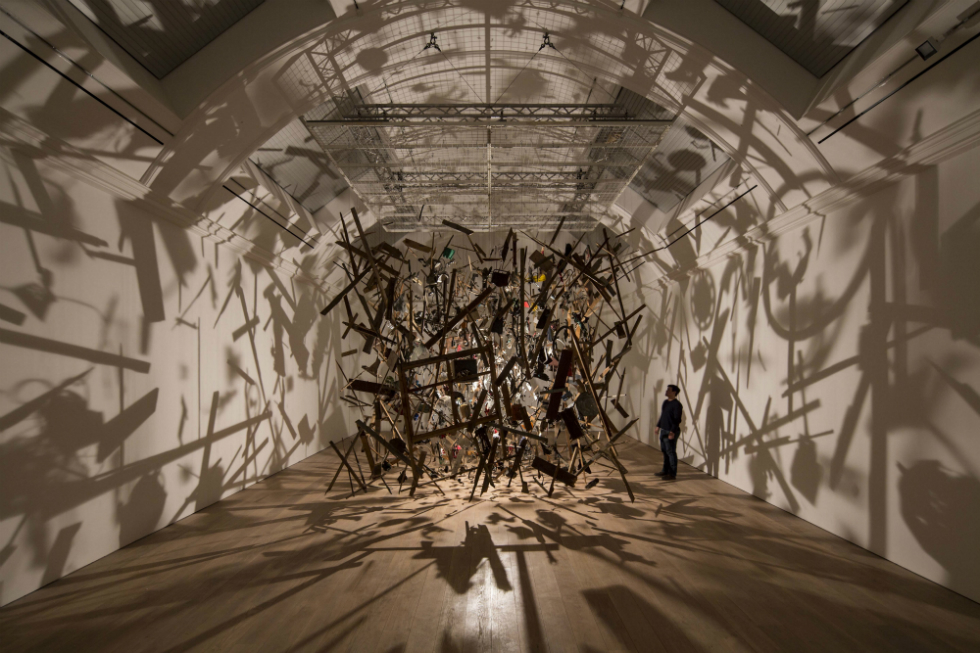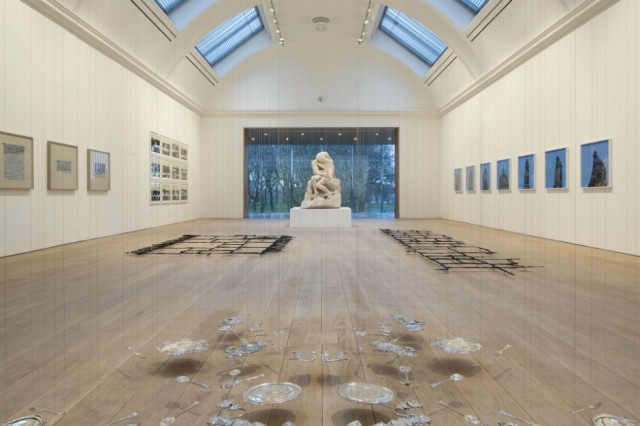The Big Interview: Cornelia Parker

Linda Pittwood catches up with the star of the reopened Whitworth Art Gallery about revisiting war and violence in her work, her relationships with power women, and why she’ll never stop collaborating…
Linda Pittwood: Hi Cornelia. My first question is: what has been your impression of the new Whitworth?
Cornelia Parker: I think it looks great. I knew it before and it used to be quite dark and the back of the museum was blocked off. You would go into dark rooms with suspended ceilings; now all those rooms have been opened up and they have lovely full height rooms and then they have been pierced in the back so that you can look through to the gardens. It is much more light and airy and the bits they have added round the side are just gorgeous. I am very happy to be doing this first exhibition.
That worked out well! How long have you been in a dialogue with Maria Balshaw about the exhibition?
Quite a long time really, two to three years, two and a half years perhaps. I first met her about three years ago and she was sounding me out about doing something in the gardens or a firework display – which I have done quite a few of as artworks – then about two years ago she asked me if I would like to do the inaugural show, which seemed a very exciting thing. The show was supposed to happen earlier, but the opening of the building was delayed. But it was worth waiting for. I think she has done an amazing job on not a huge amount of money.
Yes, it’s a really exciting thing for the city. Maria has talked about how your piece Cold Dark Matter made a huge impression on her at age 22. Did this add to the pressure as lead artist at the opening of the gallery?
A little bit! But pressure can be good, sometimes I work better under pressure. And I was given three beautiful spaces. I knew one of them was going to house the shed [Cold Dark Matter, above], the middle one was going to house a combination of different works from different periods, and that left the last room, which I wanted to make a new work for. It is very difficult to make a large-scale work without back up – that is why I think doing museum shows is brilliant. You get to realize something that you have had in your mind for a long time but not had the space or the back up to do it.
Can you tell us about that brand new work — War Room?
I wanted to make a work in response to the exploded shed, 24 years later. When I made the original piece it was partly in response to the IRA bombs going off in London, where I was living at the time and still live. That constant threat of the explosion. I had never touched anything that had been blown up, but you see it on the news and it pervades our lives, in fact it is getting worse and worse, there are more and more explosions in the world and we have the terrorist threat in Britain again. I felt I wanted to make something acknowledging war.

I had been talking to the [Imperial War Museum] about doing a war commission, which is still in the offing, and I went to the poppy factory in Richmond with a view to making a piece as part of the WW1 commemorations. I was struck by this material that I saw there, this punched out poppy paper, and I thought perhaps I should make the work for the Whitworth, because that was more present in my mind and it didn’t really fit into the war museum’s timetable.
So the idea was that the shed was blown up by the British Army and then at the other side of the war there is the British Legion making poppies, the money making industry for the dead. The shed is very dynamic and exciting and 24 years later you have a kind of chapel, a place with 3200 absences, poppy-shaped holes. A more sombre reflection on the other side of the explosion.
I think in general the WW1 commemorative pieces that have been the most successful are those that acknowledge the historical but bring in contemporary themes so that they resonate today.
Yes, the War Room isn’t really about the First World War. It is about the ongoing production of poppies, and the ongoing commemoration of the dead, a blood-red room following the explosion. Lit by four light bulbs so it is quiet and dark.
I also made a new work for the Whitworth called War Machine, which is a nine-minute film of the automated poppy factory at Ayleford, which is not where I got the poppy paper from. The machines work from 7am until 10pm all through the year apart from two weeks off. They just pound out these poppies and send them all over the world, to 80 different countries. It will never stop, I can’t imagine it ever stopping.
Have you found it a reflective process – putting together new work with work from up to 24 years ago?
Yes, it is the first time I have shown the shed in an exhibition like this. It has been in group-shows or on permanent display at the Tate. It has been quite exciting to make a response to it. I am still working with those themes, it is not as though I have left it way behind. All the work from different periods in the show seem to sit quite well together. Thematically they make quite a cohesive whole – I am not as schizophrenic as I thought I was!

Maria seems to love the fact that you and Cai Guo-Qiang, another exhibiting artist, both utilise ‘blown up’ materials. Do you think there is an interesting connection between yourself and the other artists on display for the opening?
[Cai] works with gunpowder, but his work is quite dissimilar to mine, similar materials but his work is much more painterly. His work is less quiet, my work is quite quiet really, even the shed which appears visually cacophonous. Our work comes from two different cultures, British and Chinese, but the work complements each other nicely. There is lots of other work on show, including Sarah Lucas, who has a whole room, I really love her work.
It is good to have a strong female force among the artists on display.
Yes! Just like Maria herself who is an unstoppable force and has done great things for Manchester. She is of course also the director of the City Art Gallery and she has raised money for the new venue for the Manchester International Festival. Culturally now, Manchester is really punching above its weight.
Manchester seems to be having a bit of a moment.
People are talking about the new ‘Northern Powerhouse’ – but it has always been a powerhouse! I did a show at the Cornerhouse in 1989, a really important show for me, and now I am coming back to Manchester. I grew up in Cheshire and Manchester is where I came to for culture, to see plays, and I have always been very fond of Manchester. And the Liverpool Everyman!
In your recent Guardian interview with Tim Adams I noticed he quoted your Whitworth collaborator, Nobel prize winner Konstantin Novoselov, who said that you were both working at the “extreme end of creativity”. Could you tell us a little more about working with him?
That has been remarkable – really good – we enjoyed ourselves a lot. We did things together that would have been impossible to do apart, which is always what a collaboration should be about. My invitation to him to try and make graphene from Old Master drawings was something we both got really excited about. He has a strong interest in art and the history of graphite as a drawing material, so it worked with his research but he wouldn’t have thought to do that.
I am doing a three-year honorary professorship at the Whitworth so I am going to carry on my relationship with him and with the gallery. There is a lot of unfinished business! Mary [Griffiths, curator at the Whitworth] and Maria have been like the midwives assisting me with the birth of all this new work. Women! All powerful women.
You often work in collaboration with other non-artists. Is this because it is vital to your practice or is it simply enjoyable?
It is a vital part although I don’t collaborate to produce every piece. I am not a studio-based artist, I just sometimes use it to put things in or undertake a messy process. I find myself being much more creative in conversation with other people. I prefer being on site making instant decisions. It is interesting speaking to scientists because they are not always sure what they are looking for; we just have a hunch that this is an interesting place to be. We play with materials until we find the right way into them and then make this quantum leap. It’s very rewarding – I don’t think I can stop collaborating.
Linda Pittwood
Visit Cornelia Parker’s solo exhibition at new Whitworth Art Gallery, Manchester, until 31 May 2015, free entry. Gallery open daily 10am-5pm (until 9pm on Thursday)
Café and restaurant open Monday to Friday 8am-9.30pm, Saturday 9am-9.30pm, and Sunday 10am-7pm
Want more pictures? See our press tour on Instagram
Read We Fell In Love Again: The Whitworth — Reviewed





